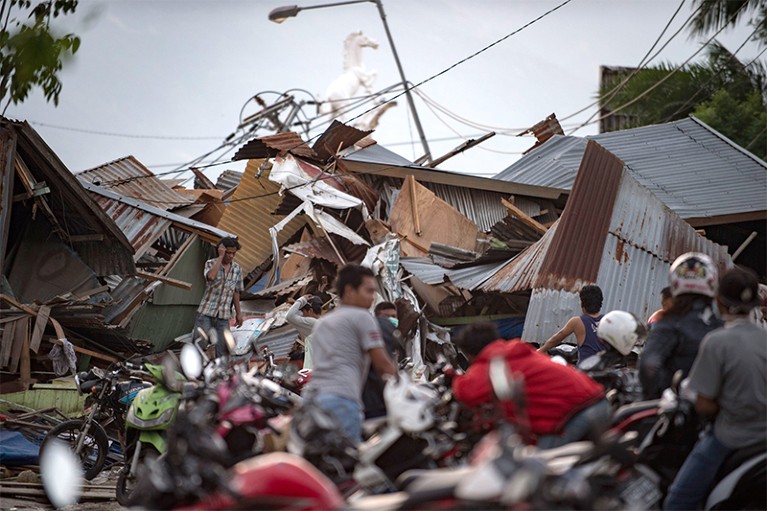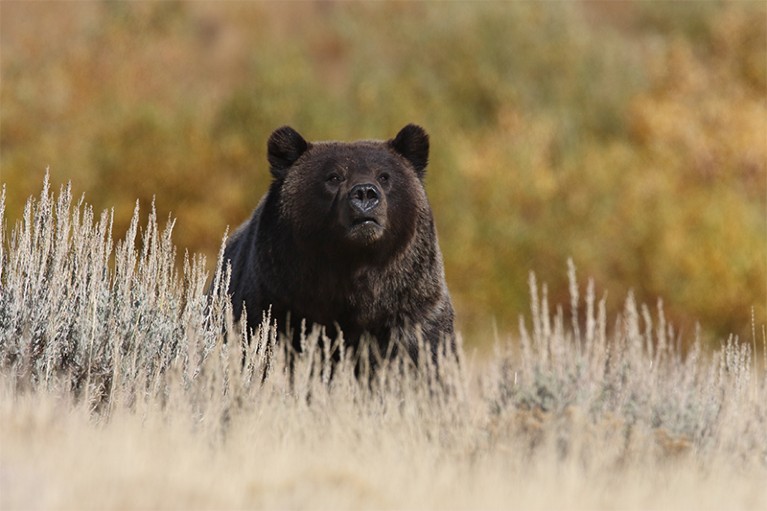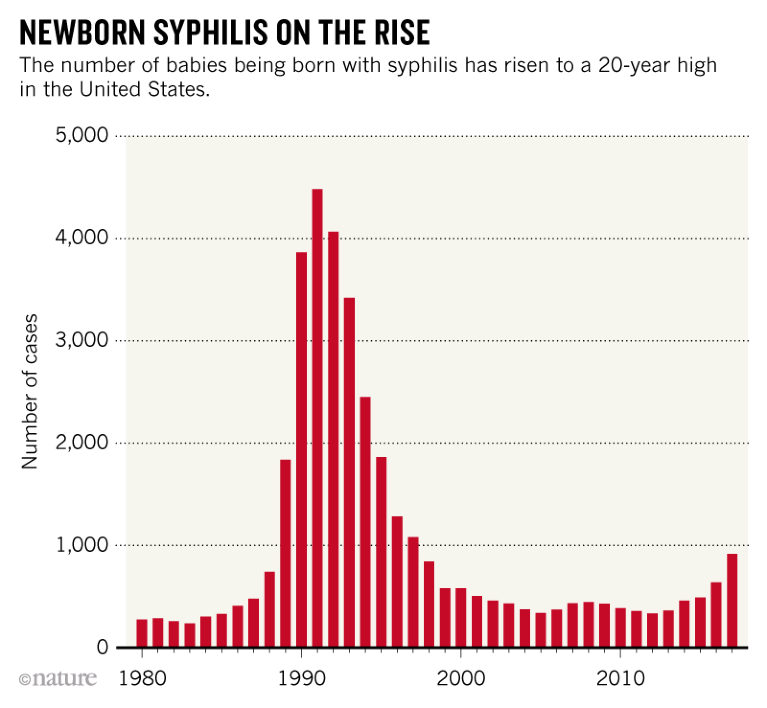EVENTS
Earthquake and tsunami rock Indonesia A magnitude-7.5 earthquake, and the tsunami it caused, has killed at least 840 people on the Indonesian island of Sulawesi. The quake struck on 28 September about 80 kilometres north of the city of Palu, triggering a tsunami that raced up a narrow inlet and into Palu. No warning sirens apparently sounded along the beach, where many people were caught in the enormous waves. Buildings collapsed across the region, which also includes the city of Donggala. Underwater landslides set off by the quake may have made the tsunami worse. Mudslides on land also swept into buildings.

The devastating impact of the recent earthquake in Sulawesi.Credit: Bay Ismoyo/AFP/Getty
POLICY
Misconduct report A report into how universities in the United Kingdom deal with sexual misconduct reveals “serious causes for concern”. The report, published by lobby organization the 1752 Group, interviewed 16 women who had experienced sexual misconduct from an academic staff member — defined as including grooming, sexual harassment, stalking or sexualized communication — and found that in only one case did the staff member involved lose their job. Many interviewees experienced retaliation, bullying, further trauma, and physical and mental-health problems during what they described as inadequate investigations by institutions into allegations. An analysis of relevant policies from 25 institutions found that some lacked detail on the procedure for handling complaints. The report calls for urgent amendment of common and problematic wording in policy documents that suggests students are responsible for avoiding abuses of power by staff.
SPACE
Observatory sign-up Ireland is joining the European Southern Observatory (ESO), becoming the 16th member state to join the partnership. Officials from the Irish government and the ESO signed the agreement in Dublin on 26 September. The decision gives Irish astronomers access to the ESO’s suite of world-class telescopes in Chile. That includes what will be the largest ground-based telescope in the world, the 39-metre Extremely Large Telescope, which is under construction and expected to come online as early as 2024. Starting in the 1840s, Ireland was home to a 1.8-metre telescope in Birr, then known as Parsonstown, which was the largest telescope in the world at the time.
Quantum CubeSat Scientists in the United Kingdom and Singapore plan to launch a quantum satellite in late 2021, they announced on 27 September. The satellite, a lightweight CubeSat, will be designed to demonstrate quantum key distribution (QKD), a technology that harnesses the quantum properties of light to provide inherently secure communication. Together, the two countries’ governments plan to invest 18 million Singapore dollars (US$13 million) in the project, known as QKD Qubesat, which will transmit secure messages between ground stations in the United Kingdom and Singapore. In 2016, a team led by Pan Jianwei at the University of Science and Technology of China in Hefei became the first to achieve satellite-based QKD, which significantly boosts the distance over which secure communication can happen.
Far-off world Astronomers have discovered a distant world in the outer Solar System. Named 2015 TG387 and nicknamed The Goblin, it never gets any closer to the Sun than about 65 times the Earth–Sun distance, or roughly twice the current distance between Pluto and the Sun. At its farthest, the object ranges out to 2,300 times the Earth–Sun distance. 2015 TG387 is one of only a handful of objects known in these distant realms. Its orbit is consistent with, but does not prove, the existence of a proposed big planet in the distant Solar System that is popularly known as Planet Nine. A team led by Scott Sheppard, at the Carnegie Institution for Science in Washington DC, discovered The Goblin using Japan’s 8.2-metre Subaru telescope on Mauna Kea, Hawaii. The researchers announced the finding on 1 October in a circular from the International Astronomical Union.
ENVIRONMENT
Yellowstone bears A US federal court has restored endangered-species protections to grizzly bears (Ursus arctos horribilis, pictured) living around Yellowstone National Park. The 24 September ruling reverses a controversial 2017 decision by the US Fish and Wildlife Service (FWS) to remove legal protections for the roughly 700 grizzlies in the Greater Yellowstone population. Judge Dana Christensen determined that the FWS had failed to consider the effects that removing these bears from the endangered-species list would have on other grizzly-bear populations in the contiguous United States. The restored protections mean that trophy hunts in Wyoming and Idaho that had been scheduled for this autumn won’t occur. The hunts could have killed up to 23 grizzly bears. It’s unclear whether the government will appeal the court ruling.

Planned grizzly hunts in Wyoming and Idaho won't go forward.Credit: Frank Fichtmüller/Getty
Sea-ice minimum Arctic sea-ice cover following this summer’s melt was the sixth lowest on record, the US National Snow and Ice Data Center in Boulder, Colorado, announced on 27 September. Sea-ice extent bottomed out for the season at 4.59 million square kilometres, tying with levels seen in 2008 and 2010. The sea ice reached its minimum this year on 23 September, which is one of the latest dates observed for this annual occurrence. The most recent calculations, from 2017, show that the September Arctic sea-ice extent has been declining by 13.2% per decade. A relatively cool July helped to slow this year’s rate of loss. Since satellite records began in 1979, the 12 lowest extents have all happened in the past 12 years. The record low came in 2012, at 3.39 million square kilometres.
PEOPLE
CERN suspension Europe’s particle-physics laboratory, CERN, has suspended an Italian theoretical physicist after he allegedly denied that physics suffers from a sexist bias and criticized positive-discrimination policies during a presentation at the lab. CERN, near Geneva, Switzerland, announced on 1 October that the physicist, Alessandro Strumia of the University of Pisa in Italy, was barred “from any activity at CERN with immediate effect, pending investigation into last week’s event”. Strumia gave his talk on 28 September. He disputes the characterization on social media of his presentation as sexist. In its statement, CERN said that Strumia’s remarks were antithetical to its code of conduct and to its values. The University of Pisa and the European Research Council, which funds his research, also say that they are opening investigations. Strumia gave his talk at the lab’s first Workshop on High Energy Theory and Gender, in front of an audience largely made up of women. The reaction on social media was quick and fierce. In response, Strumia says: “I trust that the honest majority will understand that it is the truth, and that it was worthwhile to suffer such lynching for not submitting to censorship.” Strumia, who was an ‘invited scientist’ at CERN, told Nature he hoped CERN “will want to talk and tell me what it was about my talk that was illegal.”
FUNDING
Open access Finland’s national research funder has signed up to Plan S — a push by a group of European organizations to expedite the goal of making the results of research openly available. The Academy of Finland, which announced its move on 24 September, is the first organization to sign up since Plan S was launched by 11 funders last month. The now 12-strong coalition demands that, from 2020, papers resulting from the research they fund are immediately free to read on publication. The Finnish academy handed out more than €440 million (US$510 million) in research funding in 2017.
TREND WATCH
The number of babies born in the United States with syphilis reached a 20-year high in 2017, according to a report by the Centers for Disease Control and Prevention (CDC). Reported cases totalled 918 last year, more than double the number four years earlier and the most cases in a single year since 1997. Before 2013, the number of cases had been dropping for 5 years. Syphilis is a sexually transmitted infection caused by the bacterium Treponema pallidum. Pregnant women who are infected with the bacterium can transfer it to their babies either through the placenta or during birth. If the disease isn’t treated, it can lead to premature birth, miscarriage, stillbirth or death of the baby soon after birth. Babies that survive might have deformed bones, jaundiced skin, or brain or nerve damage. The rise in cases of syphilis in newborns — known as congenital syphilis — might, in part, be a result of physicians missing opportunities to screen and treat pregnant women with syphilis, says Virginia Bowen, an epidemiologist with the CDC in Atlanta, Georgia. “Many women who are giving birth to babies are not receiving timely prenatal care,” says Bowen.

Source: CDC





